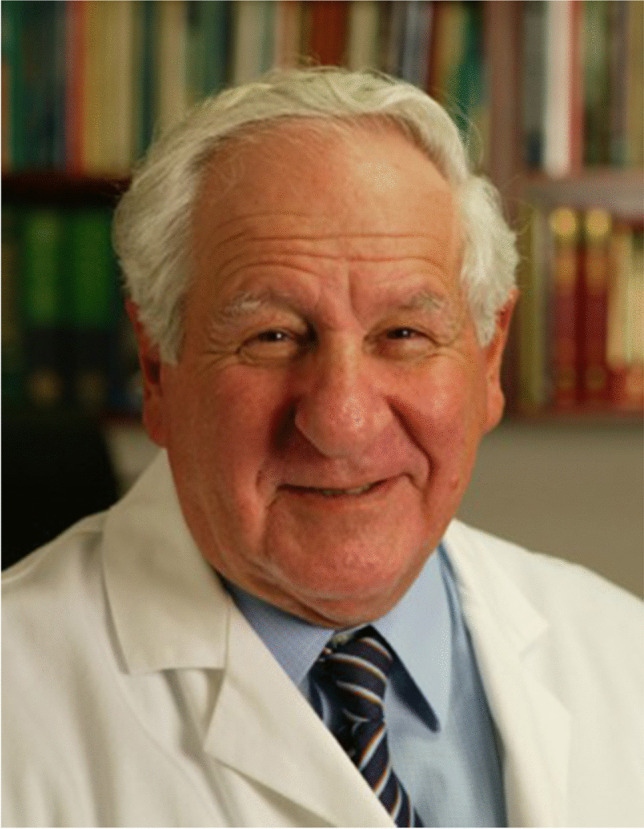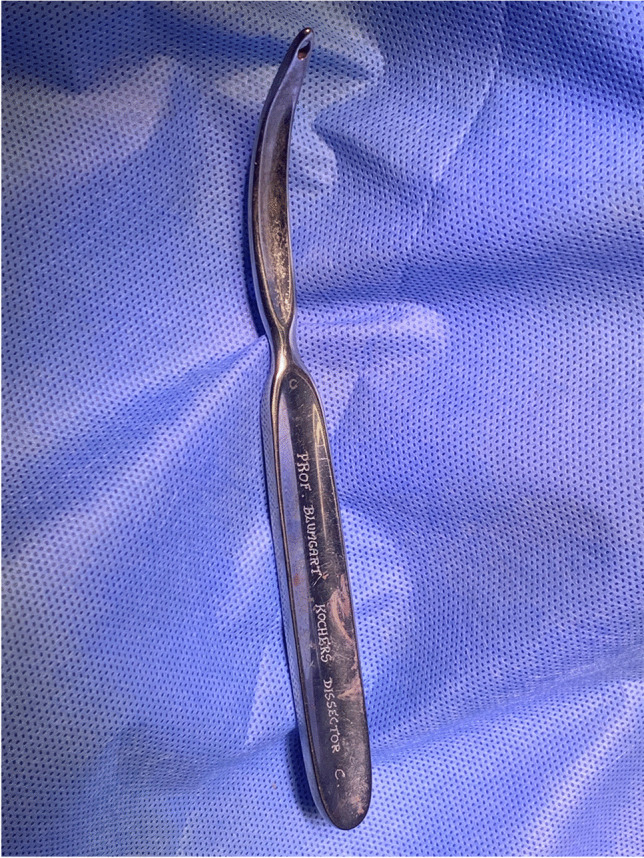Abstract
Leslie Harold Blumgart was the surgeon behind making Hepatopancreaticobiliary surgery a speciality and his recent demise will always leave a void in that field. He was the person who classified anatomical variations in the biliary tract and devised a special anastomotic technique to decrease the rate of postoperative pancreatic duct fistula after Whipple’s pancreaticoduodenectomy. His contribution in managing hepatobiliary oncology cases with chemotherapy and radiotherapy was also significant. No wonder, he was designated as the “living legend” by the International Hepatopancreaticobiliary Association.
Keywords: Hepatopancreaticobiliary, Pancreaticojejunostomy, Whipple’s surgery
If you have a biliary fistula wait and don’t repair it. Don’t rush in there like a madman. Study it. Wait some more. Think about it. And when your chief resident tells you that it needs to be fixed then fire them and wait some more. (LH Blumgart)
Introduction
Never will history of surgery witness a trained dentist from South Africa cutting across all barriers and being finally designated as a “living legend” of hepatopancreatic biliary (HPB) surgery and elected to Emeritus Faculty status at Memorial Sloan-Kettering Cancer Centre in New York.
Leslie Harold Blumgart (1931–2022) was born in South Africa, graduated BDS from Witwatersrand University in 1954. He subsequently studied at the University of Sheffield, graduating MB, ChB and MD, and was Senior Lecturer and Deputy Director of the Department of Surgery at the Welsh National School of Medicine from 1970 until his appointment to the St Mungo Chair and he was the St Mungo Professor of Surgery at the University of Glasgow from 1972 until 1979. Blumgart left Glasgow in 1979 to become Professor of Surgery at the Royal Postgraduate School of London and Director of Surgery at Hammersmith Hospital. He was Professor of Surgery at the University of Bern from 1986 until 1991, when he became Enid A Haupt Professor of Surgery at the Memorial Sloan-Kettering Cancer Centre, New York, and was appointed Chief and Director of the Programme on Hepato-Biliary Diseases in 1995. He had been Professor of Surgery at the Cornell University Medical Centre since 1992 until his death in 2022. He was a founding member and subsequently President of the International Biliary Association, which has evolved into the International Hepato-Pancreato-Biliary Association. He was awarded the Lifetime Achievement Award of the European Society of Surgical Oncology in 2014. He was decorated with honorary fellowships of the French Surgical Association, the Royal Colleges of Surgeons in Edinburgh, Glasgow and Ireland; the Austrian Society of Surgery and the Italian Society of Surgery. He was awarded the Acral Medal of the Swedish Society of Surgery. Blumgart has published over 750 peer-reviewed papers and over 150 book chapters. He has authored several books including “Blumgart’s Surgery of the Liver, Biliary Tract, and Pancreas”, currently in its 7th edition, and the “Video Atlas: Liver, Biliary & Pancreatic Surgery”. As a Visiting Professor in the United States and abroad, he had delivered around 200 extensive lectures and orations globally. At the time of his death, he had an h-index of 104 and had around 33,700 citations of his publications. He had the prestigious honour of serving on the editorial boards of 14 major journals in Surgery, Gastroenterology and Oncology. His demise on the 27th of September 2022 made the planet lose one of the leading world leaders in the field of Hepato-pancreato-biliary surgery (Fig. 1).
Fig. 1.

Professor LH Blumgart
Contribution to HPB Surgery
Blumgart was one of the most influential figures in the evolution of modern approaches to liver, pancreas and bile duct surgery. His contribution in hepatobiliary pancreatic surgery involved mainly surgical resections and reconstructions in areas where there were frequent complications, massive blood loss and high mortality earlier. He also led efforts to advance the multidisciplinary care of hepatobiliary cancer patients, improving long-term outcomes through the integration of chemotherapy and radiation therapy with surgery. He added years to the lives of all those terminal stage cancer patients of hepatobiliary tumours.
Smajda and Blumgart’s classification of the biliary tract anatomic variations is the most used classification in modern gastrointestinal surgery. This classification includes six main anatomic types—type A (normal anatomy), type B (there is no right hepatic duct, and the common hepatic duct is formed by the right anterior, right posterior and left hepatic ducts as a trifurcation), type C (there is a low drainage of one the right sectoral ducts into the common hepatic duct), type D (one of the right sectoral ducts joins the left hepatic duct), type E (the common hepatic duct is formed by the union of two or more ducts from either lobe) and type F (the right posterior sectoral duct drains into the cystic duct) [1].
The prediction of postoperative survival after hilar cholangiocarcinoma surgery depe s on two staging classifications devised by Blumgart–Bismuth Corlette (B-C) classification and Jarnagin–Blumgart (J-B) classification. J-B classification was found to be more useful than B-C classification, while its value for predicting survival did not exceed the TNM staging system. The J-B classification provides a better method to stratify hilar cholangiocarcinoma patients during the operation [2]. In a study on 380 patients, it was seen that the preoperative clinical T staging system of Blumgart, defined by the radial and longitudinal tumour extent, accurately predicted the resectability of hilar cholangiocarcinoma. The full outcomes of the benefit of resection is realized only if a concomitant partial hepatectomy is performed [3]. One of the famous quotes of Blumgart was “If you’re not looking for cure and clear margins then go home and do something else…some other form of occupational therapy!!!!”.
Blumgart described a novel technique of “duct-to-mucosa PJ” (DMPJ) using transpancreatic U “through & through” sutures during Pancreaticoduodenectomy (Whipple’s) for pancreatic cancer. His technique had no tangential tension and shear forces on the pancreaticojejunostomy site, and it is especially beneficial in the soft pancreas often present in periampullary cancer and it was possible to cover the pancreatic cut end completely with the jejunal serosa. To reduce the incidence of postoperative pancreatic fistula formation after Whipple ‘s surgery, the technique of Blumgart was modified as “compressed pancreatic stump (COMPAS) anastomosis”, based on the concept of wrapping the jejunum around the pancreatic stump without damaging the pancreatic tissue with ligature or the pressure of ligation [4]. In surgeons with an advanced knowledge in laparoscopy or robotic surgery, the laparoscopic pancreatoduodenectomy with modified Blumgart Pancreaticojejunostomy has also been described in literature [5, 6]. When the hilus of the liver is not accessible for decompression in the case of malignant obstructive jaundice, use of intrahepatic ducts for surgical bypass as a safe and effective technique was first described by Bismuth and Corlette in 1975 and later by Blumgart and Kelly in the year 1984 [7].
Nicknamed as “the Professor” by his trainees, Blumgart was a pioneering figure in the evolution of hepatopancreatic biliary surgery around the world for almost five decades and since 1991, he built as well as trained students in one of the greatest HPB clinical and academic programs at Memorial Sloan-Kettering Cancer Centre, New York. The Leslie H. Blumgart Historical Lectureship was established by the American Hepato-Pancreato-Biliary Association (AHPBA) in 2013 to offer broad historical and educational content in honour of Blumgart’s legacy.
Even during the COVID-19 pandemic, Blumgart continued his passion with teaching the fellows with his famous “Thursday lectures” every week and after retirement, he was involved in his hobby of sculpting being a gifted sculptor as well.
Stig Bengmark, Emeritus Professor of Surgery, University of Lund, Sweden, once quoted “Blumgart, Bismuth and I as a group were invited to present papers at numerous meetings. As our last names start with B, we were often introduced as “the B team”, at one time interpreted by Michael Trede as the “Bach, Beethoven, and Brahms of hepatic surgery” [8].
The hepatopancreatic biliary surgery has lost a sheen with the demise of Leslie Blumgart and his monumental contribution in making the world a better place to live for all the patients suffering from cancer of the hepatobiliary system will always be remembered and respected in the history of medicine. Many of the surgical instruments which he used during his time still bears his name engraved on it (Fig. 2).
Fig. 2.

Personal Kocher’s dissector of LH Blumgart with name engraved on it
On the death of Blumgart, Prof Jean Nicolas Vauthey, Professor, Department of Surgical Oncology, Division of Surgery, The University of Texas MD Anderson Cancer Center, Houston, tweeted “‛The Professor’ taught countless surgeons with wit, elegance and intelligence.” Prof. A.Cem İbiş from Turkey concluded “Tens of thousands of patients bear the signature of Leslie Blumgart in their hepatobiliary system without even hearing his name. The exact medical equivalent of today’s “influencer” in modern surgical era.
Declarations
Conflict of Interest
The authors declare no competing interests.
Footnotes
Publisher's Note
Springer Nature remains neutral with regard to jurisdictional claims in published maps and institutional affiliations.
Contributor Information
Kaushik Bhattacharya, Email: kbhattacharya10@yahoo.com.
Neela Bhattacharya, Email: neela.alen@gmail.com.
Utpal De, Email: utpalde9@gmail.com.
References
- 1.Kostov DV, Kobakov GL. Six rare biliary tract anatomic variations: implications for liver surgery. Eurasian J Med. 2011;43(2):67–72. doi: 10.5152/eajm.2011.16. [DOI] [PMC free article] [PubMed] [Google Scholar]
- 2.Ding G, Yang Y, Cao L, et al. A modified Jarnagin-Blumgart classification better predicts survival for resectable hilar cholangiocarcinoma. World J Surg Onc. 2015;13:99. doi: 10.1186/s12957-015-0526-5. [DOI] [PMC free article] [PubMed] [Google Scholar]
- 3.Matsuo K, Rocha FG, Ito K, D'Angelica MI, Allen PJ, Fong Y, Dematteo RP, Gonen M, Endo I, Jarnagin WR. The Blumgart preoperative staging system for hilar cholangiocarcinoma: analysis of resectability and outcomes in 380 patients. J Am Coll Surg. 2012;215(3):343–355. doi: 10.1016/j.jamcollsurg.2012.05.025. [DOI] [PubMed] [Google Scholar]
- 4.Kobayashi S, Otsubo T, Koizumi S. Novel modified Blumgart technique to reduce postoperative pancreatic fistula after pancreaticojejunostomy—compressed pancreatic stump (COMPAS) anastomosis. J Gastrointest Surg. 2021;25:1082–1086. doi: 10.1007/s11605-020-04848-4. [DOI] [PubMed] [Google Scholar]
- 5.De Pastena M, van Hilst J, de Rooij T, Busch OR, Gerhards MF, Festen S, Besselink MG. Laparoscopic pancreatoduodenectomy with modified Blumgart pancreaticojejunostomy. J Vis Exp. 2018;136:56819. doi: 10.3791/56819. [DOI] [PMC free article] [PubMed] [Google Scholar]
- 6.Inoue Y, Sato T, Kato T, Oba A, Ono Y, Mise Y, Ito H, Takahashi Y. Reproduction of modified Blumgart pancreaticojejunostomy in a robotic environment: a simple clipless technique. Surg Endosc. 2022 doi: 10.1007/s00464-022-09397-2. [DOI] [PubMed] [Google Scholar]
- 7.D’Angelica M (2007) The ligamentum teres approach and other approaches to the intrahepatic ducts for palliative bypass. In: Clavien PA, Sarr MG, Fong Y, Georgiev P (eds) Atlas of upper gastrointestinal and hepato-pancreato-biliary surgery. Springer, Berlin. 10.1007/978-3-540-68866-2_65
- 8.Bengmark S. The early days of HPB: a personal reminiscence. HPB (Oxford) 2002;4(3):117–121. doi: 10.1080/136518202760388000. [DOI] [PMC free article] [PubMed] [Google Scholar]


